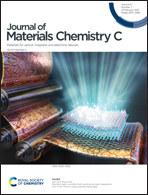Photoluminescence emission induced by localized states in halide-passivated colloidal two-dimensional WS2 nanoflakes†
Abstract
Engineering physicochemical properties of two-dimensional transition metal dichalcogenide (2D-TMD) materials by surface manipulation is essential to enabling their practical and large-scale application. This is especially challenging for colloidal 2D-TMDs that are plagued by the unintentional formation of structural defects during the synthetic procedure. However, the available methods to manage surface states of 2D-TMDs in solution phase are still limited, hampering the production of high-quality colloidal 2D-TMD inks. Here, we demonstrate an efficient solution-phase strategy to passivate surface defect states of colloidal WS2 nanoflakes with halide ligands, which results in the activation of their photoluminescence emission. Photophysical investigation and density functional theory calculations suggest that halide atoms enable the suppression of non-radiative recombination through the elimination of deep gap trap states and the introduction of localized states in the energy band structure from which excitons can efficiently recombine. Importantly, halide passivated WS2 nanoflakes retain colloidal stability and photoluminescence emission after several weeks of storage in ambient atmosphere, corroborating the potential of developed WS2 inks thereof.



 Please wait while we load your content...
Please wait while we load your content...